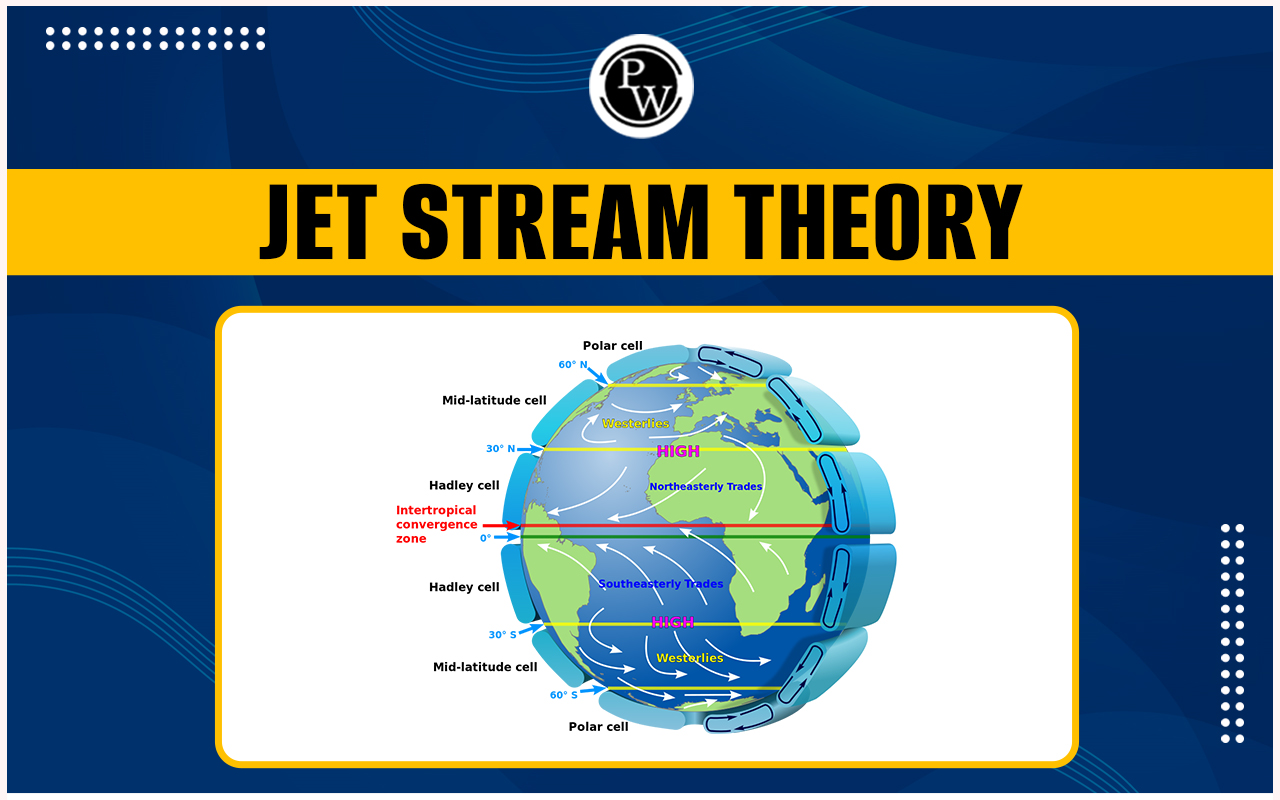

Jet Stream Theory
Jet streams are fast-flowing, narrow air currents found in the atmospheres of some planets, including Earth. They are westerly winds (flowing west to east) and are located near the altitude of the tropopause, the transition between the troposphere and the stratosphere. Understanding jet streams is crucial for meteorology, aviation, and climate science.Jet Stream Theory Overview
The Jet Stream Theory studies the narrow belt of high-altitude westerly winds in the troposphere. The speed of these winds varies seasonally, averaging 110 km/h in summer and reaching up to 184 km/h in winter. This system functions as a cover over the Earth, significantly affecting the weather in the lower atmosphere. The theory was propounded by the Yest.Driving Factors
The jet stream is driven by differences in air pressure, temperature, and moisture between various locations. The greater the temperature difference, the faster the wind velocity within the jet stream.Path Characteristics
The path of the jet stream has a meandering shape. It can start, stop, split into two or more parts, combine into one stream, or flow in various directions, including opposite to the direction of the remainder of the jet.Types of Jet Streams
- Polar Jets : These occur at higher latitudes and are stronger in the winter months due to the greater temperature contrasts.
- Subtropical Westerly Jets : Found in the subtropics, these jets also vary seasonally and play a crucial role in weather patterns.
- Tropical Easterly Jets : Less common, these jets occur in the tropics and have unique influences on regional climates.
What are Jet Streams?
Jet streams are essentially rivers of air, moving at high speeds in the upper levels of the atmosphere. They can reach speeds of over 200 miles per hour (320 kilometers per hour). These winds form at the boundaries between different atmospheric cells. On Earth, there are two main types of jet streams: the polar jet streams and the subtropical jet streams.Formation of Jet Streams
Temperature Gradient: Jet streams are primarily formed due to temperature differences between air masses. The greater the temperature difference, the faster the wind speed. This gradient is most pronounced at the boundaries between the polar and tropical air masses.
Coriolis Effect: The Earth's rotation influences the movement of air through the Coriolis effect, which causes moving air to turn to the right in the northern hemisphere and to the left in the southern hemisphere. This effect contributes to the westerly direction of jet streams.
Types of Jet Streams
Polar Jet Streams: Polar jet streams occur near the polar front, where cold polar air meets warmer air from the south. They are typically stronger in winter due to the greater temperature contrasts during this season.
Subtropical Jet Streams: Subtropical jet streams form at the boundary between tropical and subtropical air masses. They are usually found at higher altitudes than polar jet streams and are generally weaker.
Characteristics of Jet Streams
Speed and Altitude: Jet streams are located around 30,000 to 39,000 feet (9 to 12 kilometers) above sea level. Their speed can vary significantly but generally ranges from 60 to 200 miles per hour (95 to 320 kilometers per hour).
Meandering Nature: Jet streams do not flow in a straight line but rather meander in a wave-like pattern. These waves, known as Rossby waves, can have a significant impact on weather patterns.
Impact on Weather
Jet streams play a crucial role in determining weather patterns. They influence the development and movement of weather systems, such as cyclones and anticyclones. A strong jet stream can steer storm systems, leading to severe weather events.Jet Streams and Climate
The behavior of jet streams is also influenced by long-term climate changes. For example, a warming Arctic may weaken the polar jet stream, leading to more extreme weather events such as prolonged cold spells or heatwaves.Aviation and Jet Streams
For aviation, jet streams are both a boon and a bane. Flying with a tailwind from a jet stream can significantly reduce flight times and fuel consumption. However, encountering turbulence in or near a jet stream can pose challenges for aircraft.Monitoring Jet Streams
Meteorologists monitor jet streams using weather balloons, satellites, and computer models. Accurate tracking of jet streams helps in weather forecasting and planning flight routes.Future of Jet Stream Research
Ongoing research into jet streams focuses on understanding their variability and potential changes due to global warming. Improved models can help predict shifts in weather patterns and enhance climate projections. Jet streams are a fascinating and essential component of Earth's atmospheric system. Their study not only helps us understand current weather patterns but also prepares us for future climatic changes. As we continue to refine our understanding, the knowledge of jet streams will remain vital for meteorology, aviation, and climate science. To succeed in upcoming exams, candidates should consider exploring PW SSC Books We provide high-quality content at an affordable price, including sample papers, mock tests, guidance sessions, and more to ensure aspirants secure their selection. Also, enroll today on SSC Online Coaching to turn your dreams into reality.Jet Stream Theory FAQs
1. What is the Jet Stream?
2. What drives the Jet Stream?
3. What are the types of Jet Streams?
4. How does the Jet Stream affect weather?












